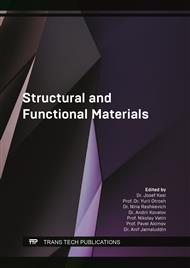[1]
Mishin, V., Sokov, V., Theoretical and technological principles of creating a new generation of thermal insulation materials in a hydrothermal power field. 1nd edn. Young Guard, Moscow (2000).
Google Scholar
[2]
Schröfl, C., Snoeck, D. & Mechtcherine, V., A review of characterisation methods for superabsorbent polymer (SAP) samples to be used in cement-based construction materials, Mater Struct 50 (2017) 197.
DOI: 10.1617/s11527-017-1060-4
Google Scholar
[3]
Lee, H., Wong, H., Buenfeld, N., Effect of alkalinity and calcium concentration of pore solution on the swelling and ionic exchange of superabsorbent polymers in cement paste, Cement and Concrete Composites, 88 (2018) 150–164.
DOI: 10.1016/j.cemconcomp.2018.02.005
Google Scholar
[4]
Xingmei, L., Fupo, H., Jiandong, Y.: Preparation, characterization and in vitro cell performance of anti-washout calcium phosphate cement modified by sodium polyacrylate. RSC Advances 7, (2017) 32842–32849.
DOI: 10.1039/c7ra03221h
Google Scholar
[5]
Chen, B., Qiao, G., Hou, D., Wang, M., Li, Z.: Cement-based material modified by in-situ polymerization: From experiments to molecular dynamics investigation. Composites Part B: Engineering 194 (2020).
DOI: 10.1016/j.compositesb.2020.108036
Google Scholar
[6]
Suresh, V., Suresh Babu, M., Achyutha Kumar Reddy, M.: Experimental study on strength and durability parameters of concrete by partial replacement of cement with sodium polyacrylate. International Journal of Civil Engineering and Technology (IJCIET) 8(1) (2017) 498–503.
Google Scholar
[7]
Ye, Q., Han, Y., Zhang, S., Gao, Q., Zhang, W., Chen, H., Gong, S., Shi, S., Xia, C., Li, J.: Bioinspired and biomineralized magnesium oxychloride cement with enhanced compressive strength and water resistance. Journal of Hazardous Materials 383 (2020).
DOI: 10.1016/j.jhazmat.2019.121099
Google Scholar
[8]
Mahon, R., Balogun, Y, Oluyemi, G., Njuguna, J.: Swelling performance of sodium polyacrylate and poly(acrylamide-co-acrylic acid) potassium salt. SN Appl. Sci. 2, 117 (2020).
DOI: 10.1007/s42452-019-1874-5
Google Scholar
[9]
Ibrahim, D., Almahdawi, F.: Addition of Super Absorbent Polymer for Upgrading of Cement Quality in Iraqi Oil Wells. Iraqi Journal of Chemical and Petroleum Engineering 17(3) (2016) 83-90.
Google Scholar
[10]
Filippova, O.: Susceptible, polymer gels. In: High Molecular Compounds, pp.2328-2352. Lomonosov Moscow State University, Moscow, (2000).
Google Scholar
[11]
Tanaka T., Filmore D., Sun S,-T, Nishio L, Swislow G., Shah A.: Phase Transitions in Ionic Gels. Physical review letters 45(1636) (2011) 97.
DOI: 10.1103/physrevlett.45.1636
Google Scholar
[12]
Kim, M., Kang, S., Hong, S., Moon, J.: Influence of Effective Water-to-Cement Ratios on Internal Damage and Salt Scaling of Concrete with Superabsorbent Polymer. Materials 12(23) (2019) 3863.
DOI: 10.3390/ma12233863
Google Scholar
[13]
Resan, D., Zemam, S., Abed, M.: Developing self-curing cement sand mortar using sodium polyacrylate. Journal of Engineering and Sustainable Development 23(5) (2019).
DOI: 10.31272/jeasd.23.5.7
Google Scholar
[14]
Chen, X., Niu, Z., Wang, J., Zhu, G., Zhou., M.: Effect of sodium polyacrylate on mechanical properties and microstructure of metakaolin-based geopolymer with different SiO2/Al2O3 ratio. Ceramics International 44(15) (2018) 18173-18180.
DOI: 10.1016/j.ceramint.2018.07.025
Google Scholar
[15]
Rao, U., Babu, M.: Study of strength parameters on concrete with partial replacement of cement by sodium polyacrylate and fly ash. International Journal of Civil Engineering and Technology (IJCIET) 8(3) (2017) 1123–1130.
Google Scholar
[16]
Kumar, B., Rao, R., Kumar, G.: Development of Normal Strength and High Strength Self Curing Concrete and Self Compacting Concrete Using Sodium Polyacrylate As A Polymer. International Journal of Scientific Research in Science and Technology (IJSRST) 3(3) (2017) 568-576.
Google Scholar
[17]
Jiang, Y., Gu, W.: Carbonation and Electrochemical Corrosion Resistance of Mild Steel Rebar in Concrete Modified by Sodium Polyacrylate as Super Absorbent Polymer exposed to 3.5 wt% NaCl Solution. Int. J. Electrochem. Sci. 16 (2021).
DOI: 10.20964/2021.06.56
Google Scholar
[18]
Rajasree, A., Vincent, P.: Experimental investigation on mechanical properties of self-curing concrete with silica fume using sodium polyarcylate and peg 6000. International Journal of Civil Engineering and Technology (IJCIET) 10 (04) (2019) 390-399.
Google Scholar
[19]
Inozemtcev, A., Korolev, E., Duong, T.: Physical and mechanical properties of cement stone with superabsorbent polyacrylate solutions, Magazine of Civil Engineering 89(5) (2019) 179–186.
Google Scholar
[20]
Yang, J., Sun, Z., Zhao, Y., Ji, Y., Li,B.: The Water Absorption-release of Superabsorbent Polymers in Fresh Cement Paste: An NMR Study. Journal of Advanced Concrete Technology 18 (3) (2020) 139-145.
DOI: 10.3151/jact.18.139
Google Scholar


